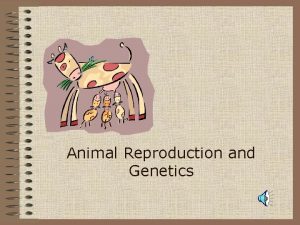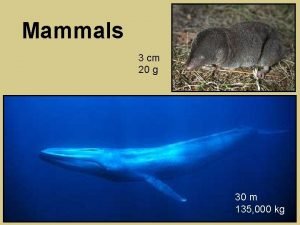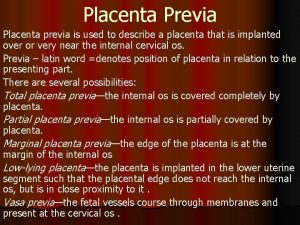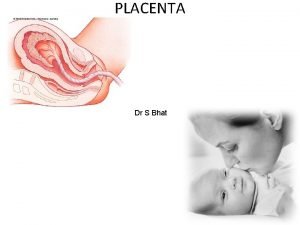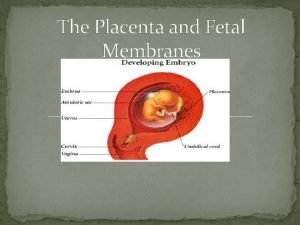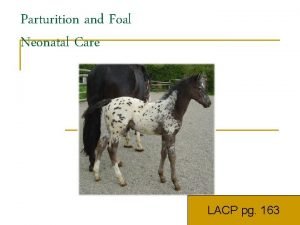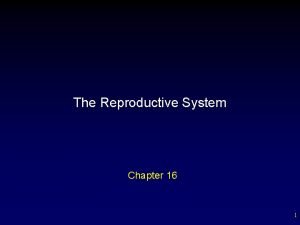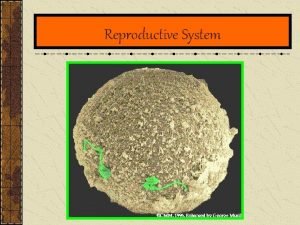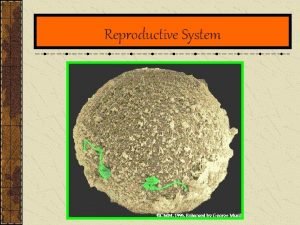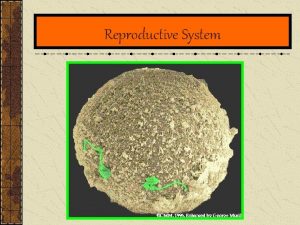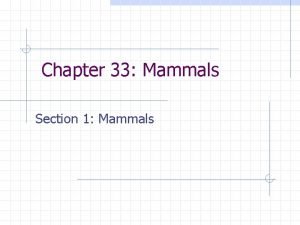REPRODUCTIVE SYSTEM OF MAMMALS MONETREMES MARSUPIALS PLACENTAL MAMMALS


















- Slides: 18

REPRODUCTIVE SYSTEM OF MAMMALS MONETREMES MARSUPIALS PLACENTAL MAMMALS. REPRODUCTIVE SYSTEM OF MAMMALS. MONETREMES MARSUPIALS PLACENTAL MAMMALS by MRS OZEMOKA H. J. is licensed under a Creative Commons Attribution-Non. Commercial-Share. Alike 4. 0 International License.

MONOTREMES

MARSUPIAL MAMMAL

HUMAN MALE REPRODUCTIVE SYSTEM The male reproductive system comprises: a pair of testes, paired accessory sex glands and ( seminal vesicles, cowper’s gland prostate gland). • a duct system for transporting spermatozoa from the testis to the penis. • •

THE MALE REPRODUCTIVE SYSTEM


THE SPERM


FRONT VIEW OF FEMALE REPRODUCTIVE SYSTEM. Click here

Female Reproductive System Female reproductive organs are for intercourse, reproduction, urination pregnancy and childbirth.

OVARIES • Ovaries are small oval organs situated in the abdominal cavity just ventral to the kidneys • The ovary consists of an inner region (medulla) and an outer region (cortex) containing egg cells or ova. These are formed in large numbers around the time of birth and start to develop after the animal becomes sexually mature. A cluster of cells called the follicle surrounds and nourishes each ovum. •

UTERINE TUBES OR FALLOPIAN TUBE A Paired tubes which receives matured ovum Fertilization occurs in the uppermost third of the tube.

UTERUS • A Hollow muscular organ infront of the rectum and behind the urinary bladder. • Consist of three layers: outer perimetrim, middle myometrium and inner endometrium.

FUNCTIONS OF WOMB 1. Sperm capacitation 2. Nutrition of the zygote by the uterine fluid before implantation 3. Sperm transport (contractions of the myometrium) 4. Gestation 5. Parturition (foetal expulsion). The uterus undergoes tremendous changes in size, structure and position during pregnancy. After parturition, uterine involution occurs and the uterus returns to its normal size.

CERVIX It is a sphincter-like structure lying between the uterus and the vagina. It is characterized by a thick wall and constricted lumen. It closes the uterus to intruders thereby preventing infection. It however relaxes during birth and sexual activites.

VAGINA The vagina is the female copulatory organ passageway for foetal and placental delivery. It extends from the urethral opening to the cervix.

EXTERNAL GENITALIA External genitalia: The external genitalia comprise of the vestibule, labia majora, labia minora, clitoris and vestibular glands. They are all referred to as vula.

ASSIGNMENT • Write on the role of hormone in pregnancy Write on the pregnancy process in humans. Explain what happens at each trimester.
 Gradualism evolution
Gradualism evolution Mammals characteristics
Mammals characteristics Basic animal reproduction crossword
Basic animal reproduction crossword Pelycosaurs
Pelycosaurs Animal without backbone
Animal without backbone Perimetrim
Perimetrim Monetremes
Monetremes Placenta prvia
Placenta prvia Placenta shapes
Placenta shapes Kleihauer-betke test
Kleihauer-betke test Confined placental mosaicism
Confined placental mosaicism Layers of the placenta
Layers of the placenta Dr june carroll
Dr june carroll Developing fetus
Developing fetus Placental examination
Placental examination Placental
Placental Modified brandt andrews technique
Modified brandt andrews technique Stages of labor
Stages of labor Figure 16-1 male reproductive system
Figure 16-1 male reproductive system


